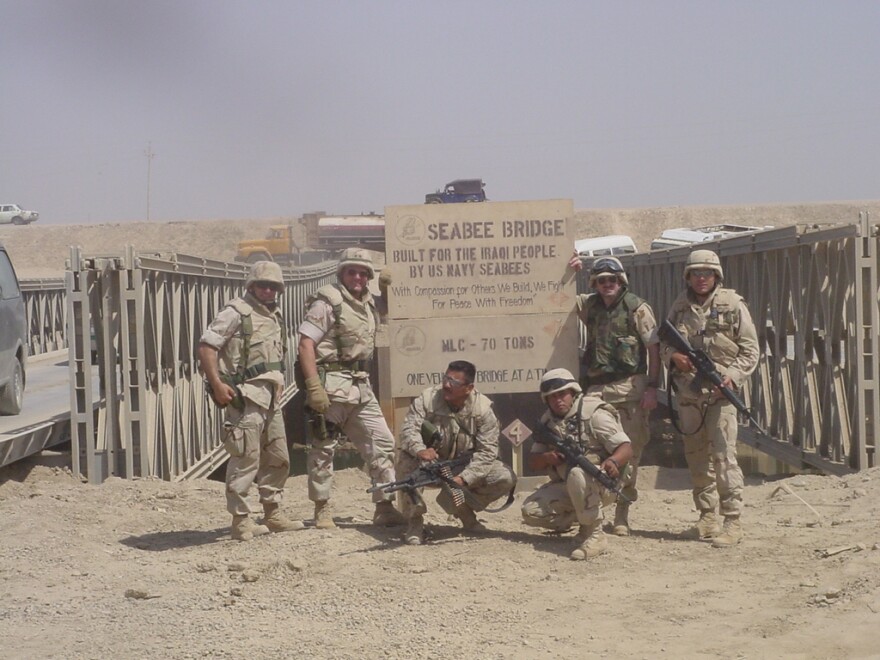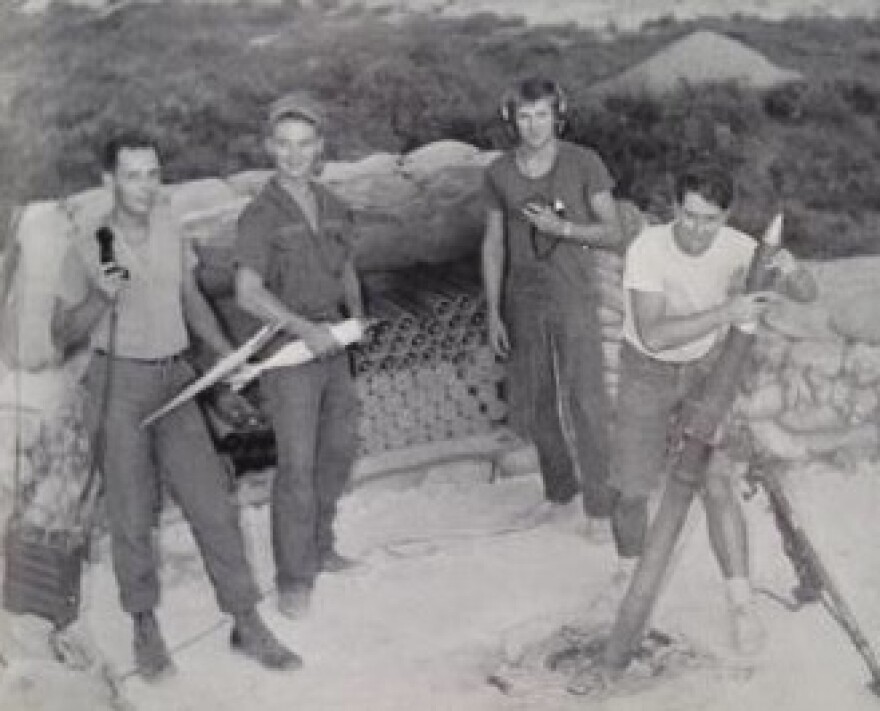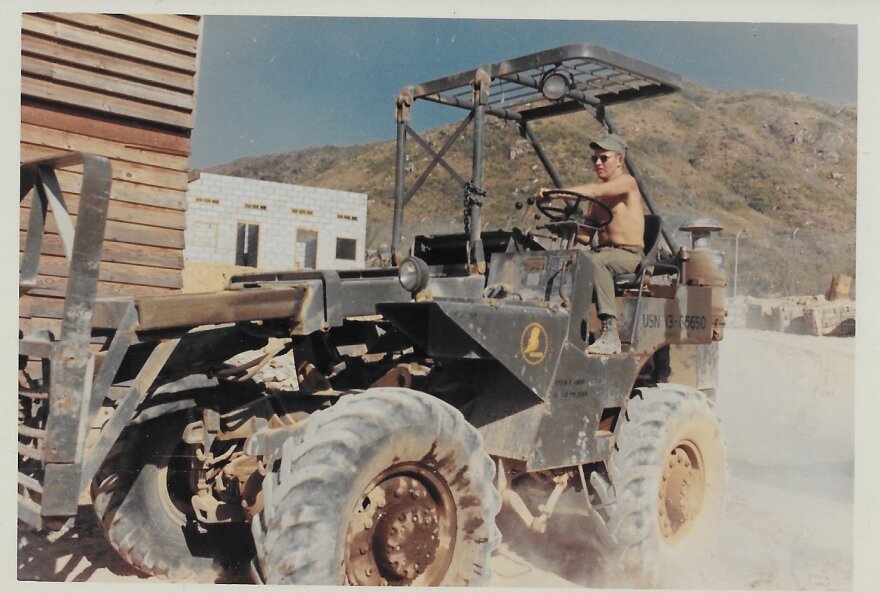March 5 marks the 75th anniversary of the United States Naval Construction
Forces…more commonly known as “The Seabees”. Although the relatively small unit has played an integral part in support of America’s military operations around the world many people have never heard of them.
SDPB’s Jim Kent sat down with a couple of these servicemen who were trained to build…and to fight…and shares their story.
If you’re a World War Two film buff or a John Wayne fan you’ve probably seen “The Fighting Seabees”. The 1944 movie offers a somewhat accurate depiction of the U.S. Naval Construction Forces.

This scene from the 1944 film explains the unit’s beginnings: Voice 1. “Mr. Donavan had a construction job on the island when the Japanese attacked, sir. Most of his crew were killed.” Voice 2. “Yes, I know.” Voice 1. “If these men had been in uniform they might still be alive. And I submit, sir, that every day this war makes more and more demands for construction under combat conditions. Airfields, roads, beach head installations. I’d like to suggest the raising of a model basic unit large enough to include the specialists and machinery to do any kind of a job. Say a thousand men, sir. Self-contained. Self-sufficient. A battalion. A construction battalion.”
Chuck Kubic retired as Commander of the Seabees in 2005 after 35 years in the service and wrote a book about his time with the Navy’s Construction Forces.
“I think the movie you mentioned depicts it very well,” says Kubic. “And the Seabees then became an integral part of both the Marine Corps island-hopping campaign as well as Seabees participated in amphibious landings at D-Day and ultimately did the pontoons that helped Patton cross the Rhine.”

Kubic notes that the unit’s primary role was to create infrastructure wherever it was needed.
“Absolutely,” he confirms. “That’s where we got our motto ‘We Build. We Fight.’ And so we were basically created from the construction trades. In many cases people were pulled from civilian jobs. The average age of the Seabee in World War Two was 37 where the average age of the Marine was 19. And so the standing story was ‘Be nice to the Seabees. He could be some Marine’s father. They were generally older but they were skilled in construction and then they had to be trained to fight as infantry.”
The Seabees served throughout the Pacific and European theatres during World War Two and never looked back. They went on to provide construction support during the Korean War and in 1955 began deploying yearly to Antarctica to build and expand scientific bases there. The first group of 200 Seabees distinguished themselves by constructing a 6,000-foot ice runway on McMurdo Sound in spite of a raging blizzard.

Located on Main Street in downtown Rapid City sits the Veterans of Foreign Wars Post 1273. I’m here to meet two more former Seabees.
Dick Turnwall was born in Aberdeen, South Dakota. He grew up on a farm but tilling the soil wasn’t in Turnwall’s blood so he joined the military to see what else the world had to offer.
“I was a Seabee,” Turnwall explains. “I was an equipment operator. And then I was also a U.S. Navy diver. I was in the U.S. Navy from 1968 to 1998.”
No sooner had Turnwall joined then the 19-year old found himself in Vietnam.
“We’re in a war zone,” he recalls. “You not only have to build things, you have to be able to defend yourself and protect what you’re building. So we have a lot of weapons qualifications that go log with being a Seabee.”
Rifles, grenade launchers, machine guns…you name it…the Seabees qualified for it. And it wasn’t long after his arrival in Nam that Turnwall was putting that weapons training to use. But he says the Seabees were generally safer than others in the combat zone.

“We would work out on the roads that were off of our camp,” Turnwall explains. “So we weren’t out beating the bush like the Army and the Marines. We were building things. So every night we were in a camp. A couple of times we’d get mortared at night. But much safer than some of the folks that were…the grunts.”
Not so fellow South Dakotan and Seabee Roger Andersen who enlisted a few years earlier than Turnwall and found himself right in the middle of the Tet Offensive.
“How was that?” I ask.
“No fun,” Andersen replies. “Lost some friends. When I first got that I was on security so I ran the .81 mortars for the battalion. Did that for 3 months and then I transferred out to the rock crusher. I think there was 26 of us Seabees and about a hundred Marines around the rock crusher and then guarding the bridge at the river…which usually got blown up and then they’d put pontoons floating you back and forth. But we came under attack several times at the rock crusher because we were so small.”
But Vietnam was only a small part of Andersen’s career and like Dick Turnwall he traveled the world for years doing what he loved to do best…building.

Asked why the public generally knows so little about the Seabees, Turnwall replies because it’s a small unit, they’re frequently deployed overseas and their only main bases are in Mississippi and California.
“There’s only about 10,000 active-duty Seabees so…it’s a real small group,” Turnwall observes. “So we kind of get forgotten about that way because of the size. It’s probably one of the best kept secrets the Navy’s got.”
Dick Turnwall and Roger Andersen both enjoyed their Seabee careers…so much so that they each would have stayed in past their retirement.
But there are other men…and women…carrying on the Seabee traditions that Turnwall, Andersen and the thousands before then carved into the Navy’s history beginning in 1942. And as Roger Andersen points out they may be known as “The Fighting Seabees” but their first job is to build.
Note - The Seabees 75th anniversary dinner takes place at the Rapid City Golden Corral on Saturday, March 4, 2017 at 5:00 p.m. Mountain Time.

